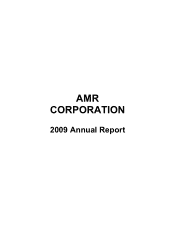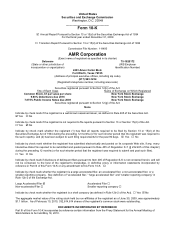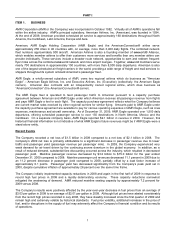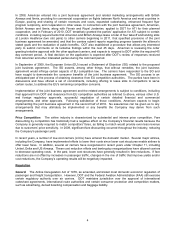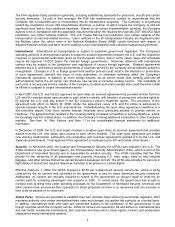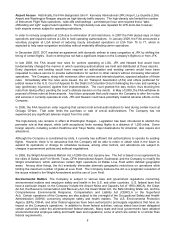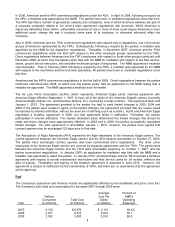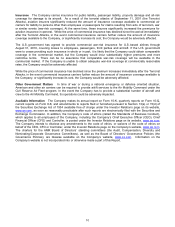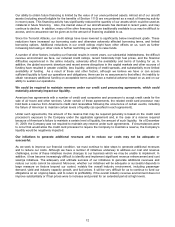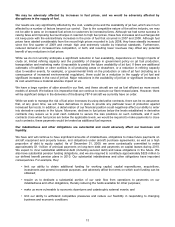American Airlines 2009 Annual Report Download - page 6
Download and view the complete annual report
Please find page 6 of the 2009 American Airlines annual report below. You can navigate through the pages in the report by either clicking on the pages listed below, or by using the keyword search tool below to find specific information within the annual report.3
The American Eagle® carriers increase the number of markets the Company serves by providing connections at
American’s primary markets, and Boston and Raleigh/Durham. The AmericanConnection® carrier currently
provides connecting service to American through St. Louis. In 2010, this service is expected to be repositioned to
provide connecting service to American through Chicago O’Hare to support American’s previously announced
network restructuring. American's competitors also own or have marketing agreements with regional carriers
which provide similar services at their major hubs and other locations.
On most of its domestic non-stop routes, the Company faces competing service from at least one, and sometimes
more than one, domestic airline including: AirTran Airways (Air Tran), Alaska Airlines (Alaska), Continental Airlines
(Continental), Delta Air Lines (including Northwest Airlines) (Delta), Frontier Airlines, JetBlue Airways (JetBlue),
Hawaiian Airlines, Southwest Airlines (Southwest), Spirit Airlines, United, US Airways, Virgin America Airlines and
their affiliated regional carriers. Competition is even greater between cities that require a connection, where the
major airlines compete via their respective hubs. In addition, the Company faces competition on some of its
connecting routes from carriers operating point-to-point service on such routes. The Company also competes with
all-cargo and charter carriers and, particularly on shorter segments, ground and rail transportation. On all of its
routes, pricing decisions are affected, in large part, by the need to meet competition from other airlines.
Most of the Company’s largest domestic competitors and several smaller carriers have reorganized under the
protection of Chapter 11 of the U.S. Bankruptcy Code (Chapter 11) in recent years. It is possible that one or more
of the Company’s competitors may seek to reorganize in or out of Chapter 11. Successful reorganizations present
the Company with competitors with significantly lower operating costs derived from renegotiated labor, supply and
financing contracts.
International Air Transportation In addition to its extensive domestic service, the Company provides
international service to the Caribbean, Canada, Latin America, Europe and Asia. The Company's operating
revenues from foreign operations (flights serving international destinations) were approximately 40 percent of the
Company’s total operating revenues in 2009, and 40 percent and 37 percent of the Company’s total operating
revenues in 2008 and 2007, respectively. Additional information about the Company's foreign operations is
included in Note 14 to the consolidated financial statements.
In providing international air transportation, the Company competes with foreign investor-owned carriers, foreign
state-owned carriers and U.S. airlines that have been granted authority to provide scheduled passenger and
cargo service between the U.S. and various overseas locations. In general, carriers that have the greatest ability
to seamlessly connect passengers to and from markets beyond the nonstop city pair have a competitive
advantage. In some cases, however, foreign governments limit U.S. air carriers' rights to carry passengers
beyond designated gateway cities in foreign countries. To improve access to each other's markets, various U.S.
and foreign air carriers – including American – have established marketing relationships with other airlines and rail
companies. American currently has marketing relationships with Air Pacific, Air Tahiti Nui, Alaska Airlines, British
Airways, Brussels Airlines, Cathay Pacific, China Eastern Airlines, Dragonair, Deutsche Bahn German Rail, EL
AL, Etihad Airways, EVA Air, Finnair, GOL, Gulf Air, Hawaiian Airlines, Iberia, JAL, Jet Airways, LAN (includes
LAN Airlines, LAN Argentina, LAN Ecuador and LAN Peru), Malév Hungarian Airlines, Mexicana, Qantas Airways,
Royal Jordanian, SNCF French Rail and Vietnam Airlines.
American is also a founding member of the oneworld alliance, which includes British Airways, Cathay Pacific,
Finnair, LAN Airlines, Iberia, Qantas, JAL, Malév Hungarian, Mexicana, and Royal Jordanian. The oneworld
alliance links the networks of the member carriers to enhance customer service and smooth connections to the
destinations served by the alliance, including linking the carriers' frequent flyer programs and access to the
carriers' airport lounge facilities. Several of American's major competitors are members of marketing/operational
alliances that enjoy ATI. American and British Airways, the largest members of the oneworld alliance, are
restricted in their relationship because they currently lack ATI for commercial cooperation. They are, therefore, at
a competitive disadvantage vis-à-vis other alliances that have ATI for such cooperation.

